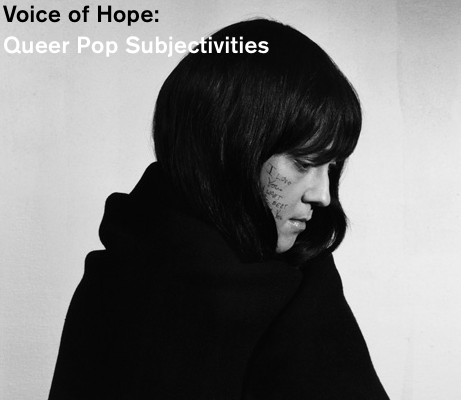|
| The voice of Antony Hegarty has been close to ubiquitous as of lately. It is part of the sound of artists as diverse as Marc Almond, Björk, CocoRosie, and Lou Reed, to mention only some of those with whom he has collaborated.[1] But it has also been heard in films, such as V for Vendetta, where it is played by the jukebox in an important scene, as well as the recent Bob Dylan film I’m Not There, where Antony is singing “Knocking on Heavens Door”.[2] In addition, of course, there is his own band, Antony and the Johnsons, with their two albums; the self-titled Antony and the Johnsons and I am a Bird Now, with a third album, The Crying Light, due for release in 2008.[3] Born when Ziggy Stardust raided the airwaves, and becoming teenager around the time when Frankie told us to “Relax” and Boy George was asking “do you really want to hurt me?”, Antony might be placed in a long history of popular-music singers.[4] This history questions dimensions of the gendered understanding of popular music, questions having become increasingly persistent in recent years. And co-existing with Antony’s reaching out to a more mainstream audience, the rise of queer studies within musicology might be fruitfully used to discuss Antony’s music.[5] |  | 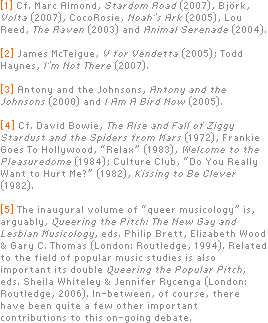
| 
|  |  | It is not easy to describe the music on Antony’s albums, but his voice is even more difficult to describe. It is, however, this voice that is the focal point of this article. But the voice never – or hardly ever – exists alone. Even if we often listen to voices as if they were detached from all possible contexts, the voice is still intimately related to other domains, perhaps foremost among them the body. In one sense is it paradoxical to contemplate the voice without a body, but this used to be quite common, and within music scholarship there has been some controversy related to thinking “the body”.[6] But the disembodied voice is at the same time frequently what we hear, for example when listening to a CD. One reason is that the voice is elusive. In “live” situations the voice’s utterance (whether speaking or singing) disappears in the moment it sounds. Listening to a CD, the bodily carrier of the voice might be in another place; we listen to “the voice alone”. And thus, it might seem, it is forgotten that this voice at one time emanated from a body. |  | 
| 
|  |  | Keeping this in mind, the voice still demands attention. There is a power of the voice seemingly drawing us towards it, and this power is part of Antony’s performance too. This does not mean that we should forget the intimate relation between voice and body, but even the “voice alone” as an abstract medium contains traces of the body. What Roland Barthes famously called “the grain of the voice” is, among other dimensions, traces of the body as it is attached to the voice.[7] In this sense we hear the singer’s body, and his – or her – voice is caressing us. There is, then, an erotic relation between singer and listener. The voice, as an abstract entity in the singular, is a construct; there is no singular voice, but rather different vocal expressions. And when we hear a voice, we simultaneously hear a body. The voice emanates from the body, and the body – with all its different characteristics – colors the voice. And this is the case even when thinking of so-called “disembodied voices”. |  | 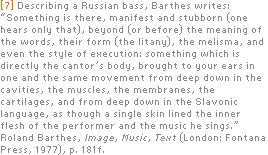
| 
|  |  | 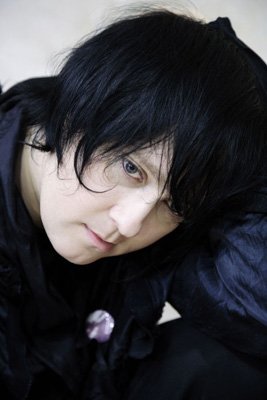
|  | | 
|  |  | 
|  |  | 
|  |  | Remembering the voice’s intimate relation to a body, we immediately also come across issues related to gender and/or sex. Bodies are gendered and sexed, and this has consequences for how we hear – or experience – voices. There is a strong tendency to claim that voices are gendered and/or sexed in a similar manner to bodies, and from this it also follows that as with theories of sexual difference, there are theories of vocal difference. We tend to think we know what a “male” or a “female” voice is. Ascribing gender to a voice seems to be a rather self-explanatory endeavor. And it seems as if sexual difference hardly ever is seen as a problem in this task. There are male voices and female voices, and voices are categorized without much effort into one or the other. Beginning to discuss voices more thoroughly, one finds that there are also other kinds of voices, voices that resist such an easy categorization. Some possible gender-ambivalent voices might be the voice of the castrato, different computer-technologized voices (such as the cyborg-voice), and, to a lesser degree, counter-tenor voices. Here, things become a bit blurrier, given how such voices challenge familiar understandings of the voice. In the case of Antony, as well as the already mentioned David Bowie and Boy George (as well as a host of other singers), these questions are never simple. Different gendered expressions exist also in relation to the voice, as has been discussed, for example, related to androgynous voices. An androgynous voice is per definition neither “male” nor “female”. It might be described as genderless, but also as having “too much” gender to it; thus rather than pointing to a solution to any discussion of the gendered voice, the androgynous voice opens up a totally different field of examination. Yet another dimension might enter the discussion of ambiguities related to voice: the words. Focusing on the lyrics when trying to interpret the voices, we can hear other strategies for negotiating gendered and/or sexed identities. That is to say, it seems somewhat self-evident that the “content” or “message” of a song is communicated by way of the lyrics. Here too we find an abstraction: the singing voice is, so to speak, an entity in-between music (the tones of the song) and word (the lyrics), and these two dimensions together constitute the voice we hear. There is of course the possibility of having a singing voice without words, but when words are included they also contribute to the sound of the voice. Here an example could be listening to songs in languages one doesn’t know or understand. |  | | 
|  |  |
| |
| 
Antony’s voice comes across as “different”. It has to do with his use of vibrato, the way he employs pitch, and the very sound of the voice, something notoriously difficult to pin down in words. Not that one would misperceive – if that is the word – it as the voice of a woman. But even stating the point in this way shows show much sexual difference is taken for granted when discussing the voice. Descriptions of his voice have often used words such as “angelic” and “ethereal,” and he has been called “a creature” as if to challenge any notion of a gendered human being. The term “creature” might obviously constitute a problem here. It is as if the humanity of Antony is questioned, and the term quite obviously might have a transphobic ring to it. It also resembles how, historically, the voice of the castrato was described, as angelic or monstrous, and thus in a particular sense non-human.[8] But, as with the voice of the castrato, this also opens up the possibility of describing a queer voice.[9] And Antony’s voice is, in a particular sense, a queer voice, and I understand this term primarily as signifying a non-normative voice. Invoking the term queer, however, at the same time means that one will have to define, somewhat clearer, what queer (could) mean. |  | 

| 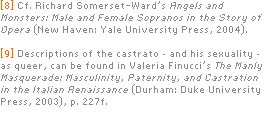
| 
|  |  | 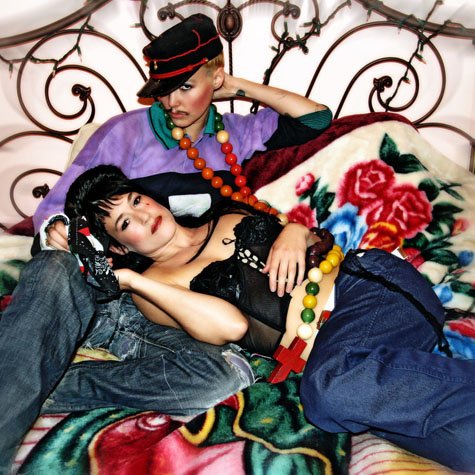
|  | | 
|  |  | 
|  |  | 
|  |  | A good place to start is listening to Antony’s voice on the song “Beautiful Boyz” from CocoRosie’s album Noah’s Ark (2005). Antony is singing the chorus, “all those beautiful boyz”, whereas Bianca Leilani Casady (“Coco”) is singing the verses, about a “he” that might or might not be “Antony”. Here his voice challenges some of the traditional understandings of gender. We hear a queer voice, but the queerness is still not easily interpreted. The queerness at least partly comes through as a result of the interplay of voice, melody, and lyrics. The text interferes in the discussion, given its more explicit expression, its more concrete content, and as such establishes frames of interpretation. But the queerness also results from the interplay between Coco and Antony, where a staging or performance is taking place, albeit without any clear-cut or determined meaning. The song is left open. |  | | 
|  |  | Born illegitimately
To a whore most likely
He became an orphan
He was sent to the reformatory
Ten years old was his first glory
Got caught stealing from a nun
Now his love story had begun Thirty years he spent wandering
A devil’s child with dove wings
He went to prison
In every country he set foot in
Oh how he loved prison All those beautiful boyz
Pimps and queens and criminal queers
All those beautiful boyz
Tattoos of ships and tattoos of tears His greatest love was executed
The pure romance was undisputed
Angelic hoodlums and holy ones
Angelic hoodlums and holy ones All those beautiful boyz … |  | | 
|  |  | A key reference, however, is obviously the “beautiful boyz”; they being, in one way or another, outcasts: “Pimps and queens and criminal queers”. They are outsiders; they challenge normativity; and they are thus Antony’s co-conspirators as well. The images and language used partake in the construction of gender. These “boyz” – the outsiders – are at the same time tightly interwoven with understandings of masculinity. But when speaking about masculinity it is imperative to employ this term in the plural; masculinities. The inherited image of gender is challenged, and as soon as there are several understandings it becomes difficult to uphold a “normative” or “normal” version of masculinity. The plurality thus opened is inscribed as repetitions of figures, a logic being central because showing that there are no “free choices” when one “chooses” a gendered identity. There are existing scripts one becomes inscribed into. I am not claiming that there is no agency here, just that one can never choose totally as one sees fit. Within this logic we find that the repetitions are never of “the same”; there is a difference inscribed.[10] In the repetitions, then, we find the meeting-point between sameness and difference. |  | 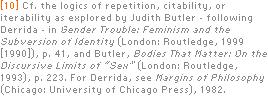
| 
|  |  | 
An increasingly important part of the popular music culture is what could be termed a voicing of queer subjectivities.[11] Antony is a good example for such a discussion, but to make some of these dimensions clearer, in this passage I will compare one song by Antony with another from Rufus Wainwright. Such a comparison hopefully will throw light on some of the different strategies for voicings of the queer subjectivities; different strategies simultaneously showing the differences for non-normative identity-constructions. Antony and Rufus have collaborated on several occasions; Rufus singing duet with Antony on “What Can I Do?” from Antony and the Johnson’s I Am A Bird Now (2004), and Antony singing duet with Rufus on “Old Whore’s Diet” from Wainwright’s Want Two (2005). These duets show something particular about the respective voices, not least when compared with how these singers’ voices are heard when they sing alone. The duets underline other dimensions in the voices, primarily in the interplay between them, where the question “who’s on top?” might be applied to say something about these differences.[12] Other examples where this play is put forward can be found on I Am A Bird Now, best heard in “You Are My Sister,” when Antony sings together with Boy George, and on “Fistful of Love”, when Lou Reed collaborates. |  | 
| 
| 
|  |  | Rather than discussing these duets, two other songs, from the same albums, might be used to describe different strategies for the voicing of queer subjectivities: Wainwright’s “The Art Teacher” and Antony’s “For Today I Am A Boy”. They are both sung in the first person, but rather than clearly voicing a first-person narrative these versions of “first person” establishes a persona. Here it should be remembered that the very term “person” comes from Latin per sonara, meaning the voice or sound (sonara) coming out through a theatrical mask (originally in Latin plays). In other words, the person/a is intimately related to masquerades, to metaphors taken from the theater, and thus to a play of and with the personal as a voicing of some kind of persona. Subjectivity, in this sense, is a staging, a representation, but at the same time a “making-present” – and this not least through the voice – a role, rather than some kind of essential being behind the mask. |  | | 
|  |  |
| |
If this is discussed by way of theories of performance and performativity, and if this “person/a” is understood as a copy, then this is a copy without an original.[13] There are, as already mentioned, differentiations within the repetitions. Different vocal levels within musical performances have been underlined within opera-studies and popular music studies for quite some time. They make it possible for us to hear several voices so to speak in the “same” voice; it is not necessarily the case that it is the performer’s own voice (whatever that is) that we are hearing.[14] Dividing up different layers heard in a musical performance might throw some light on this. In his book Performing Glam Rock, Philip Auslander distinguishes three such layers: “the real person”, “the performance persona”, and “the character”.[15] These layers of course interact (and co-exist), and any division between them is thus highly heuristic. This heuristic dimension, however, might also cover up for the play of ambivalence at stake in such performances; it tends to “normalize” the ambivalent subject position, making it in one particular sense “straight”. The queer positions I am after in this article might, as my examples hopefully will show, complicate this whole picture, making it necessary to introduce either more “personas” or combining the different layers in other ways. “The Art Teacher” is sung from a pretty straightforward female position. Wainwright sings in the persona of a woman, where the song, in particular as captured in the text, is about her schooldays and her art teacher: |  | 

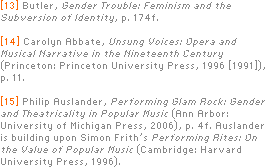
| 
|  |  | There I was in uniform
Looking at the art teacher
I was just a girl then;
Never have I loved since then He was not that much older than I was
He had taken our class to the Metropolitan Museum
He asked us what our favorite work of art was,
But never could I tell it was him
Oh, I wish I could tell him –
Oh, I wish I could have told him I looked at the Rubens and Rembrandts
I liked the John Singer Sargents
He told me he liked Turner
Never have I turned since then
No, never have I turned to any other man All this having been said,
I married an executive company head
All this having been done, a Turner – I own one
Here I am in this uniformish, pant-suit sort of thing
Thinking of the art teacher
I was just a girl then;
Never have I loved since then
No, never have I loved any other men |  | | 
|  |  | The text is from the female point of view, from her subject-position, whereas the voice we hear is a male voice. In other words, there is an ambivalence between the two levels. It is, however, heard as a man singing from a female’s point of view, and thus the ambivalence is relatively easily handled. But still, even with the ambivalence taken care of, it is still a challenge to any thought of an easy division of sexual difference.[16] Antony’s “For Today I Am A Boy”, on the other hand, is sung from a much more ambivalent position.
One day I’ll grow up, I’ll be a beautiful woman
One day I’ll grow up, I’ll be a beautiful girl
But for today I am a child, for today I am a boy
For today I am a child, for today I am a boy. One day I’ll grow up, I’ll feel the power in me
One day I’ll grow up, of this I’m sure
One day I’ll grow up, I’ll know a womb within me
One day I’ll grow up, feel it full and pure
But for today I am a child, for today I am a boy
For today I am a child, for today I am a boy.
Here we find possibilities of transgression or transformation; a possibility of change or movement between ascribed gender-identities. When the “I” – that is to say, the singer’s persona – grow up, s/he will be a woman. But for today s/he is a boy. The text points towards a potential crossing-over; the possibility of changing or moving between ascribed identities. But even in addition to the lyrics, the voice challenges. The “ethereal”, “angelic” voice of Antony, with the implicit difficulties of a clear-cut gendered identity, in short, the transgendered voice of Antony, contributes to the ambivalence heard, complicating the script. |  | 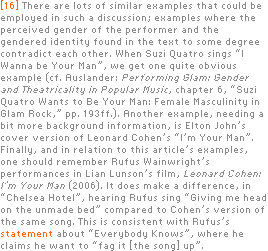
| 
|  |  | It is not as if we hear any “core” subjectivity in these voices; we hear a voice performing and we hear different kinds of subject-formations. Given the tendency to ascribe some kind of agency to the artist and/or singer – a thought that they sing “about” themselves – the performing dimension opens up a field of negotiation for the interpretation of this music.[17] The same is at stake when interpreting poetry; do we hear the poet’s own self in the poems? In this context we should remember the difference between a poem and a song; listening to a song, we hear much more than the text. Perhaps the text is even the least interesting dimension. This, however, opens up for yet another layer: in addition to listening to the (presupposed) subjectivity of the artist, and to the subjectivity of the lyrics, we also listen to the subjectivity of the voice. These layers exist simultaneously, but the way we understand them, there is still a tendency to understand the voice as more intimately related to the subjectivity. The voice is so to speak our inner coming out; it resembles the “soul” as something existing in the body, with the possibility of “coming out”. |  | 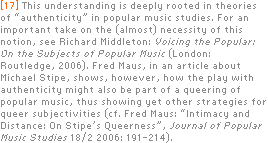
| 
|  |  | 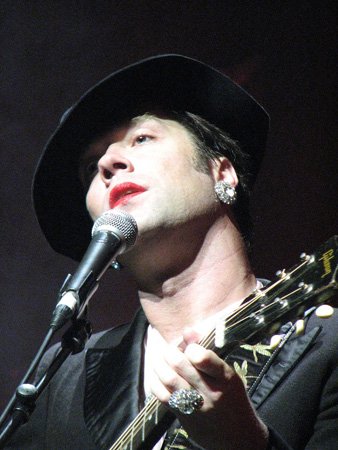
|  | | 
|  |  | 
|  |  | 
|  |  | When Rufus sings “I was just a girl then” he quite obviously, on the level of lyrics, challenges any straightforward identification between the singer and the text. Here we find a parallel to Judith Halberstam’s discussion, in Female Masculinity, of the “bathroom problem”.[18] This “problem” is related to divisions of gender in the case of public toilets, and Halberstam discusses how persons belong to one or the other. And this belonging is dependent upon looks; any surveillance of people will here take the visual as marker for which toilet a person belongs in. And as Halberstam exemplifies, when speaking the “gender-ambivalent” person will “prove” her or his belonging, the voice seemingly giving away the “correct” gender. But with song, we find another take on this. There seems to exist a parallel “voice problem”, in the sense that we have a tendency to ascribe gender to voices without much problem. We have male voices and female voices. But as Rufus demonstrates, the question is never that simple. As the “naturalness” of gender and/or sex has been questioned, so has the “naturalness” of the vocal register, as well as the supposed “genderedness” of the voice. And one of the things happening in “The Art Teacher” is that a presumed man sings from a woman’s point of view and from her subject-position and her experience, thus opening up for another way of listening both to the voice and to the subjectivity found “inside” it. So where Antony sings “for today I am a boy,” Rufus almost sings “yesterday I was a girl”. And Antony of course adds something to the effect of “tomorrow I’ll be a woman.” There is, then, a movement suggesting that the subject-position is something changing, being not identical with itself, but a field of negotiation, a field where different emotions, different experiences, are forever negotiated. And, in the wish – the wish for difference, the strive towards something else – these movements and potentialities are found. As when Antony wishes to become a beautiful woman, or when Rufus wishes s/he could tell him, could have told him. |  | 
| 
|  |  |
|

As we have learned from Judith Butler, however, “there is no ‘I’ who stands behind discourse and executes its volition or will through discourse”. The “I” comes into being through being called, named, or interpellated.[19] What does this, then, imply for analyzing a song where the singer utters an “I” (as both Antony and Rufus do)? Within a culture dominated by the wish for a clear-cut gender divide, these in-between-ness’es are a challenge. And maneuvering in-between seems to demand some kind of passing. To a certain extent both Rufus and Antony stage dimensions of passing; Antony in a temporal sense, that one might pass for “something else” at another point in time, Rufus in the sense where the “poetic subject” tries to pass as a woman. This resembles Halberstam’s description of identity as “a process with multiple sites for becoming and being”, as a way of articulating a plurality, where identity is exactly not “identity” in the sense of a core.[20] Both Antony and Rufus stage such a “multiple site” in challenging us to hear different subjectivities found in their songs. Where Halberstam describes the bathroom as “a limit of gender identification” there are, then, similarities to the voice.[21] Perhaps we need some kind of suspension of disbelief to be able to negotiate listening to a voice and still being open to it presenting gender ambivalence? |  | 

| 
| 
|  |  | The discussion of diverse forms of “gender deviance” in Halberstam’s use of the “bathroom problem” might also be extended towards a discussion of the voice. Here the quite open definition of “transgender” she articulates in In a Queer Time and Place, might be helpful. “The term transgender”, she writes, “can be used as a marker for all kinds of people who challenge, deliberately or accidentally, gender normativity”, and then she moves on to discuss the voice of the Jazz singer Jimmy Scott.[22] Scott’s voice is in-between, and is also one of the voices compared to Antony’s. The quality of Scott’s voice is due to a medical condition – Kallmann’s syndrome; a hormonal dysfunction – and this gives him a high voice and an androgynous look. Here we find parallels to theories of “vocal drag” or “vocal cross-dressing”. But these terms might be misleading. Discussing gender performativity and drag, the notion of passing comes into play again. One important dimension here is related to different versions of performativity: embodying or performing gender norms on the one hand and the performative use of discourse on the other. But it is also crucial that drag works differently in the visual domain compared to the aural one. Cross-dressing visually is not the same as trying to pass vocally. Also in Halberstam’s discussion we see how the voice might give away the assigned gender of the “gender deviant” person; in other words, how it breaks the spell of cross-dressing and “reveals” the person behind the mask. In the visual domain it is important here to differentiate between cross-dressing and drag, as well as between a theatrical cross-dressing and a “real-life” transgendered “identity”. It might be, that is to say, easier to cross-dress on stage than in “real life”. Related to my two examples it is also crucial to discuss – and not least to challenge – the division between performativity and performance. Butler claims that “the reduction of performativity to performance would be a mistake”.[23] However, this is one of the ways she has been read, and the alternative, or rather, the differentiation between the two, is not necessarily easy to state. Butler claims that “drag is an effort to negotiate cross-gendered identification”, but this seems clearly to be in the visual domain.[24] How could this be translated into the aural domain, as is necessary for the term “vocal drag” to have the same effect? |  | 
| 
| 
|  |  | 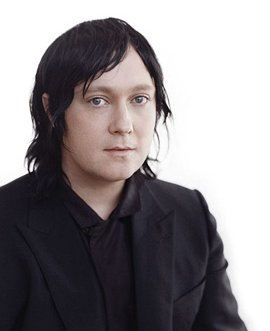
| 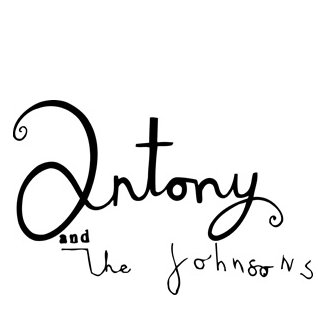
| 
|  |  | 
|  |  | 
|  |  | 
What is happening with Antony? And why does this have consequences for our understandings of gender? In my view there is here a kind of mainstreaming of what used to be known as “deviance.” At the same time we find, in the case of Antony, more of this than the dimensions of gay-aesthetics more commonly taking place within popular music. Not that this is totally new, but there are some differences. Antony, as transgendered, reaches a “mass-audience” and to a certain extent this is new. But we see some possible paradoxes here, and it is not given that such a mainstreaming will open up for acceptance related to gender-identities (or what Halberstam calls gender-deviance). Taking these expressions into mass-culture or mainstream might take away the edge.[25] And it is not given either that the culture is opening up to a broader field of gendered identities. But there is a hope, a hope of acceptance, a hope of the acceptance of difference, and, as Antony himself is singing: “Hope there’s someone …” |  | 
| 
|  |  | Hope there’s someone
Who’ll take care of me
When I die, will I go Hope there’s someone
Who’ll set my heart free
Nice to hold when I’m tired There’s a ghost on the horizon
When I go to bed
How can I fall asleep at night
How will I rest my head Oh I’m scared of the middle place
Between light and nowhere
I don’t want to be the one
Left in there, left in there There’s a man on the horizon
Wish that I’d go to bed
If I fall to his feet tonight
Will allow rest my head So here’s hoping I will not drown
Or paralyze in light
And godsend I don’t want to go
To the seal’s watershed Hope there’s someone
Who’ll take care of me
When I die, Will I go Hope there’s someone
Who’ll set my heart free
Nice to hold when I’m tired |  | | 
|  |  | It might be naïve to see such a hope as being a hope for a greater acceptance of “gender deviance” or “queerness.” On the other hand, that might be one possible consequence of the mainstreaming taking place in the case of Antony. Before 2000 Antony was clearly under the radar, a subcultural phenomenon. But today he is ubiquitous; his voice is heard in the most unlikely places. As Halberstam writes, “the mainstream recognition and acknowledgement of a subculture has the potential to alter the contours of dominant culture,” but she adds that “most of interest directed by mainstream media at subcultures is voyeuristic and predatory”.[26] The voyeuristic dimension might be more difficult to attach to Antony’s voice, and his highlighting both “beautiful boyz”, out-casts, and the rights of transgendered persons, might thus, perhaps, show a way. This is, however, not the only way for a queer musicology to pursue its different tasks. But the strategies employed by Antony might show some possibilities of voicings of queer subjectivities. |  | 
| 
|  |  | 
|  |  |
|
